
The Type A Ko-hyoteki class was a class of Japanese midget submarines (Kō-hyōteki) used during World War II. They had hull numbers but no names. For simplicity, they are most often referred to by the hull number of the mother submarine. Thus, the midget carried by I-16-class submarine was known as I-16's boat, or "I-16tou."
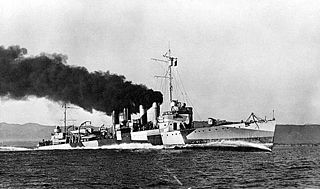
USS Ward was laid down as a 1,247-long-ton (1,267 t) Wickes-class destroyer in the United States Navy during World War I, later converted to a high speed transport in World War II. She was responsible for the first American-caused casualties in the Pacific in World War II when she engaged and sank a Japanese midget submarine before Japanese aircraft arrived in the attack on Pearl Harbor, killing both crewmen on board.

I-25 (イ-25) was a B1 type (I-15-class) submarine of the Imperial Japanese Navy that served in World War II, took part in the Attack on Pearl Harbor, and was the only Axis submarine to carry out aerial bombing on the continental United States in World War II, during the so-called Lookout Air Raids, and the shelling of Fort Stevens, both attacks occurring in the state of Oregon.

HMAS Australia (I84/D84/C01) was a County-class heavy cruiser of the Royal Australian Navy (RAN). One of two Kent-subclass ships ordered for the RAN in 1924, Australia was laid down in Scotland in 1925, and entered service in 1928. Apart from an exchange deployment to the Mediterranean from 1934 to 1936, during which she became involved in the planned British response to the Abyssinia Crisis, Australia operated in local and South-West Pacific waters until World War II began.
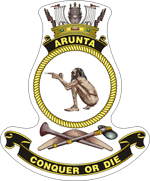
HMAS Arunta (I30/D5/D130) was a Tribal-class destroyer of the Royal Australian Navy (RAN). Named for the Arrernte Aboriginal peoples, the destroyer was laid down in 1939 and commissioned into the RAN in 1942.

There was considerable Axis naval activity in Australian waters during the Second World War, despite Australia being remote from the main battlefronts. German and Japanese warships and submarines entered Australian waters between 1940 and 1945 and attacked ships, ports and other targets. Among the best-known attacks are the sinking of HMAS Sydney by a German raider in November 1941, the bombing of Darwin by Japanese naval aircraft in February 1942, and the Japanese midget submarine attack on Sydney Harbour in May 1942. About 40 Allied merchant ships were damaged or sunk off the Australian coast by surface raiders, submarines and mines. Japanese submarines also shelled three Australian ports and submarine-based aircraft flew over several Australian capital cities.

HMAS Kuttabul, formerly SS Kuttabul, was a Royal Australian Navy depot ship, converted from a Sydney Ferries Limited ferry.

From 31 May to 8 June 1942, during World War II, Imperial Japanese Navy submarines made a series of attacks on the Australian cities of Sydney and Newcastle. On the night of 31 May – 1 June, three Ko-hyoteki-class midget submarines, each with a two-member crew, entered Sydney Harbour, avoided the partially constructed Sydney Harbour anti-submarine boom net, and attempted to sink Allied warships. Two of the midget submarines were detected and attacked before they could engage any Allied vessels. The crew of M-14 scuttled their submarine, whilst M-21 was successfully attacked and sunk. The crew of M-21 killed themselves. These submarines were later recovered by the Allies. The third submarine attempted to torpedo the heavy cruiser USS Chicago, but instead sank the converted ferry HMAS Kuttabul, killing 21 sailors. This midget submarine's fate was unknown until 2006, when amateur scuba divers discovered the wreck off Sydney's northern beaches.
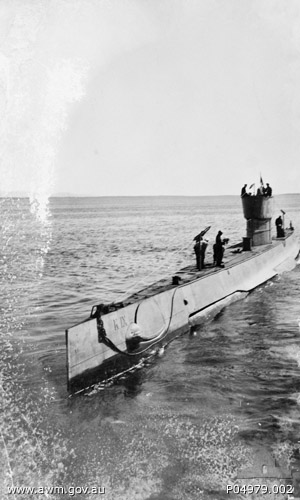
HMAS K9 was a submarine that served with the Royal Netherlands Navy and the Royal Australian Navy.
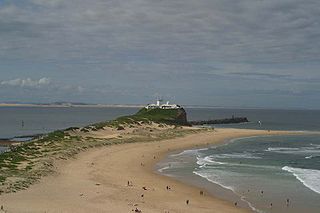
Newcastle East is an inner city suburb of Newcastle, New South Wales, Australia, located immediately east of Newcastle's central business district at the mouth of the Hunter River. The Awabakal and Worimi peoples are acknowledged by City of Newcastle as the descendants of the traditional custodians of the land situated within the Newcastle local government area, including wetlands, rivers creeks and coastal environments. It is known that their heritage and cultural ties to Newcastle date back tens of thousands of years. The suburb includes Fort Scratchley, Newcastle Ocean Baths and Newcastle Beach. Formerly a site of heavy industry and railway yards, the suburb now contains the large Foreshore Park, and historic terraced housing.

Fort Scratchley, a former coastal defence installation, is now a museum. It is located in Newcastle East, a suburb of Newcastle, New South Wales in Australia. It was built in 1882 to defend the city against a possible Russian attack. However, its guns were not fired in anger until 8 June 1942, during the shelling of Newcastle. The Australian Army left the site in 1972.
The second I-22 was one of five Type C cruiser submarines of the C1 sub-class built of the Imperial Japanese Navy. During World War II, she operated as the mother ship for a midget submarine during the attack on Pearl Harbor and the attack on Sydney Harbour, supported Japanese forces during the Battle of the Coral Sea, and served in the Guadalcanal campaign. She was sunk in October 1942.

The second I-24 was one of five Type C cruiser submarines of the C1 sub-class built for the Imperial Japanese Navy. During World War II, she operated as the mother ship for a midget submarine during the attack on Pearl Harbor and the attack on Sydney Harbour, supported Japanese forces during the Battle of the Coral Sea and the Battle of the Santa Cruz Islands, and served in the Guadalcanal campaign, New Guinea campaign, and Aleutian Islands campaign. She was sunk in June 1943.

The Bombardment of Ellwood during World War II was a naval attack by a Japanese submarine against United States coastal targets near Santa Barbara, California in February 1942. Though the damage was minimal, the event was key in triggering the West Coast invasion scare and influenced the decision to intern Japanese-Americans. The event also marked the first shelling of the North American mainland during the conflict.
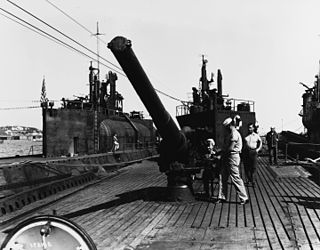
The 14 cm/40 11th Year Type naval gun was the standard surface battery for Japanese submarine cruisers of World War II. Most carried single guns, but Junsen type submarines carried two. Japanese submarines I-7 and I-8 carried an unusual twin mounting capable of elevating to 40°. The appended designation 11th year type refers to the horizontal sliding breech block on these guns. Breech block design began in 1922, or the eleventh year of the Taishō period in the Japanese calendar. The gun fired a projectile 14 centimeters (5.5 in) in diameter, and the barrel was 40 calibers long.
The shelling of Port Gregory took place on 28 January 1943 during World War II. The attack was conducted by the Japanese submarine I-165, under the command of Lieutenant Commander Tatenosuke Tosu, as a part of attempts to divert Allied attention away from the evacuation of Japanese forces from Guadalcanal, in the Solomon Islands. None of the 10 shells fired at Port Gregory caused any damage, and the attack was not noticed by the Allied naval authorities until a radio signal sent by Tosu was intercepted and decoded a week later.
On 3 August 1942 the fishing trawler Dureenbee was attacked and badly damaged by Japanese submarine I-175 off the town of Moruya, New South Wales. Three of the trawler's crew were killed, and the ship was subsequently damaged beyond repair after running aground. While the incident has been called a war crime, Allied submarines also conducted similar attacks during World War II.
M24 Japanese Midget Submarine wreck site is a heritage-listed former midget submarine and now archaeological site located in unincorporated waters off Sydney's Northern Beaches in New South Wales, Australia. The Ko-hyoteki-class midget submarine was designed by the Imperial Japanese Navy and built from 1941 to 1942 by Kure Naval Yard or Ourazaki Naval Yard. The site was added to the New South Wales State Heritage Register on 7 December 2007.

The Shepherds Hill military installations is a New South Wales state heritage-listed site, consisting of a former military gun battery emplacement, observation post and gunner's cottage at The Terrace in Newcastle, New South Wales, Australia. It was built from 1890 to 1940. It is also known as Shepherds Hill Defence Group Military Installations, Observation Post and Gun Placement and Shepherds Hill Battery. It was added to the New South Wales State Heritage Register on 2 July 2010.

HMAS Lolita (14) was formerly a luxury motor cruiser, commissioned as a channel patrol boat into and operated by the Royal Australian Navy (RAN) during World War II. She was one of thirteen similar vessels, known to Sydney siders as the 'Hollywood Fleet'.
















